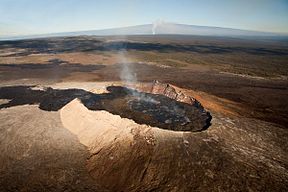Mt. Kilauea
| Kīlauea | |
|---|---|

Puʻu ʻOʻo, a vent on the east rift zone of the Hawaiian volcano Kīlauea
|
|
| Highest point | |
| Elevation | 4,091 ft (1,247 m) |
| Prominence | 50 ft (15 m) |
| Coordinates | 19°25′16″N 155°17′12″W / 19.421097472°N 155.286762433°WCoordinates: 19°25′16″N 155°17′12″W / 19.421097472°N 155.286762433°W |
| Geography | |
| Location | Hawaiʻi, United States |
| Geology | |
| Age of rock | 300,000 to 600,000 years old |
| Mountain type | Shield volcano, hotspot volcano |
| Volcanic arc/belt | Hawaiian–Emperor seamount chain |
| Last eruption | January 3, 1983 – present |
Kīlauea (/ˌkiːlaʊˈeɪə/, US: /ˌkɪləˈweɪə/; Hawaiian: [tiːlɐwˈwɛjə]) is a currently active shield volcano in the Hawaiian Islands, and the most active of the five volcanoes that together form the island of Hawaiʻi. Located along the southern shore of the island, the volcano is between 300,000 and 600,000 years old and emerged above sea level about 100,000 years ago.
It is the second youngest product of the Hawaiian hotspot and the current eruptive center of the Hawaiian–Emperor seamount chain. Because it lacks topographic prominence and its activities historically coincided with those of Mauna Loa, Kīlauea was once thought to be a satellite of its much larger neighbor. Structurally, Kīlauea has a large, fairly recently formed caldera at its summit and two active rift zones, one extending 125 km (78 mi) east and the other 35 km (22 mi) west, as an active fault of unknown depth moving vertically an average of 2 to 20 mm (0.1 to 0.8 in) per year.
...
Wikipedia

